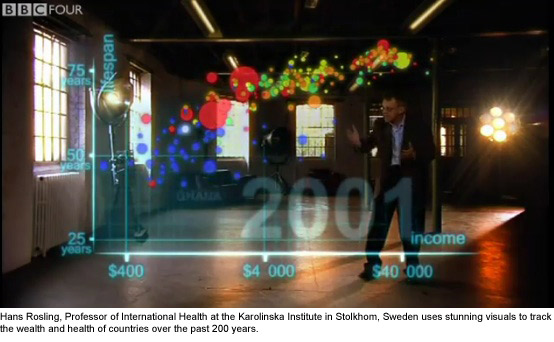Related Posts
var a2a_config = a2a_config || {};
a2a_config.linkurl = "http://mondaymorning.web.unc.edu/2010/12/13/unequal-health-improvement/";
200 years of health in 4 minutes!

You might have seen a 4-minute video Jimmy Rosen, MBA, MSPH (alumnus, InterSouth Partners, and member of our Public Health Foundation Board) sent me. If you haven’t, it’s really amazing. Hans Rosling, Professor of International Health at Karolinska Institute, gives a brilliant example of how new visualization techniques can change our understanding of phenomena. We can see how 200 years ago, most people in most countries were poor and sick. Over the ensuing 200 years, countries diverged so that some progressed and others were left behind. Over time, more and more countries are being pulled upward, to be healthier and wealthier overall. But even countries that are high on wealth and health still have pockets of poverty and ill health. The video makes it clear why people in venture capital should care about health—because of its correlation with wealth. Those of us on the healthy side should not forget the strong relationship between poverty and ill health as well as less education and poorer health. See David Brooks’ mention of Rosling’s YouTube video in his latest column: “Ben Franklin’s Nation.”
North Carolina health ranking disappoints
I was thinking about some of these issues when I read the latest report from America’s Health Rankings. North Carolina ranks 35 in health among all states, slightly improved from 37 in 2009. We’re better than that! What’s our problem? First, our health behaviors need work: 20% of us still smoke, higher than 36 other states. We’re 39th in obesity and 42nd in the proportion of incoming ninth graders who will graduate from high school (only 69%). Nearly 25% of NC children live in poverty, spelling worse health, as the earlier video showed. We’re 44th in infant mortality.
In a state that has some of the very best medical schools and tertiary care centers, the top public school of public health and some of the best public health departments in the U.S., ranking 35 should signal us to work harder to improve the people’s health. It’s also a reminder that our state’s fiscal crisis, with more budget and job cuts coming, is likely to make health even worse over the next few years.
As I think about what we, the school of public health, could do, working together with colleagues in medical centers and health departments, I recognize that most NIH and CDC grants aren’t designed to improve the health of large populations. Our foundations have suffered financial losses due to the recession, and funding is essential to good outcomes. We should start talking with our public health colleagues about what behaviors and outcomes we could influence positively so that a few years from now, we’ve moved substantially upward.
Happy Monday! Onward and upward! We are nearing the end of the term as commencement approaches next weekend. Barbara
